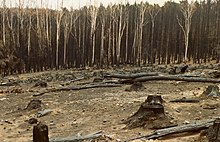
Back Buschfeuer in Victoria und South Australia 1983 German Incendies du Mercredi des Cendres de 1983 French 1983年オーストラリア森林火災 Japanese Ash Wednesday Polish Пожары Пепельной среды Russian 1983年澳大利亚个圣灰星期三大火 WUU
| Ash Wednesday bushfires | |
|---|---|
 Aftermath of the 1983 Ash Wednesday bushfires at Mount Macedon | |
| Date(s) | 16 February 1983 |
| Location | Australia: Victoria and South Australia |
| Statistics | |
| Burned area | 2,080 km2 (513,979 acres) in South Australia and 9,954 square kilometres (2.46 million acres) in Victoria on one day; 5,200 square kilometres (1.28 million acres) burnt throughout the 1982/83 season[1][2] |
| Land use | Urban/rural fringe areas, farmland and forest reserve |
| Impacts | |
| Deaths | 75 (47 – Victoria) (28 – South Australia) |
| Non-fatal injuries | 2,676[1] |
| Ignition | |
| Cause | Faulty powerlines, arson, and negligence after years of extreme drought 3,700 homes and buildings lost |
The Ash Wednesday bushfires, known in South Australia as Ash Wednesday II,[3] were a series of bushfires that occurred in south-eastern Australia in 1983 on 16 February, the Christian holy day Ash Wednesday. Within twelve hours, more than 180 fires fanned by hot winds of up to 110 km/h (68 mph) caused widespread destruction across the states of Victoria and South Australia.[4] Years of severe drought and extreme weather combined to create one of Australia's worst fire days in a century.[5] The fires were the deadliest bushfire in Australian history until the Black Saturday bushfires in 2009.
75 people died as a result of the fires; 47 in Victoria, and 28 in South Australia. This included 14 Country Fire Authority and three Country Fire Service volunteer firefighters.[6][7] Many fatalities were as a result of firestorm conditions caused by a sudden and violent wind change in the evening which rapidly changed the direction and size of the fire front.[8][9] The speed and ferocity of the flames, aided by abundant fuels and a landscape immersed in smoke, made fire suppression and containment impossible.[10] In many cases, residents fended for themselves as fires broke communications, cut off escape routes and severed electricity and water supplies.[11] Up to 8,000 people were evacuated in Victoria at the height of the crisis and a state of disaster was declared for the first time in South Australia's history.[6][8]
A 2001 report found Ash Wednesday to be one of Australia's worst fires.[12] More than 3,700 buildings were destroyed or damaged and 2,545 individuals and families lost their homes. Livestock losses were very high, with more than 340,000 sheep, 18,000 cattle and numerous native animals either dead or later destroyed.[13] A total of 4,540 insurance claims were paid totalling A$176 million with a total estimated cost of well over A$400 million (1983 values) for both states, equivalent to A$1.3 billion in 2007.[1][14] The emergency saw the largest number of volunteers called to duty from across Australia at the same time—an estimated 130,000 firefighters, defence force personnel, relief workers and support crews.[15]
- ^ a b c "Southern Victoria and S.A: Bushfires". E.M.A Disasters Database. Emergency Management Australia, Australian Government. 13 September 2006. Archived from the original on 12 February 2009. Retrieved 25 May 2008.
- ^ Cite error: The named reference
dsewas invoked but never defined (see the help page). - ^ CFS :: Bushfire History Archived 29 August 2010 at the Wayback Machine
- ^ "About Ash Wednesday". Country Fire Authority Victoria, Australia. Archived from the original on 23 March 2008. Retrieved 10 May 2008.
- ^ Bureau of Meteorology. "Climate Education: Ash Wednesday, February 1983". Australian Government. Archived from the original on 8 August 2013. Retrieved 10 May 2008.
- ^ a b Collins, Paul (2006). Burn: The Epic Story of Bushfire in Australia. Sydney: Allen and Unwin. ISBN 1-74175-053-9.
- ^ "Memorials to Firefighters: Remembering Our Fallen". South Australian CFA Promotions Unit. Country Fire Service. Archived from the original on 11 February 2009. Retrieved 16 May 2008.
- ^ a b Murray, Robert; Kate White (1995). State of Fire: A History of Volunteer Firefighting and the Country Fire Authority in Victoria. Melbourne, Australia: Hargreen Publishing Company. ISBN 0-949905-63-1.
- ^ Webster, Joan (2000). The Complete Bushfire Safety Book. Sydney, Australia: Random House Australia. ISBN 1-74051-034-8.
- ^ Miller, S.I (1984). Report of the Bushfire Review Committee: On Bushfire Disaster Preparedness and Response in Victoria, Australia Following The Ash Wednesday Fires 16 February 1983. Melbourne, Australia: State Government of Victoria. pp. 23–24.
- ^ Smith, Stewart (2002). "Bushfires. Briefing Paper No. 5/02" (PDF). NSW Parliamentary Research Library Research Service. Archived from the original (PDF) on 28 May 2008. Retrieved 17 May 2008.
- ^ "Economic Costs of Natural Disasters in Australia. (Report 103)" (PDF). Bureau of Infrastructure Transport and Regional Economics, Australian Government. 2 January 2001. Archived (PDF) from the original on 28 May 2008.
- ^ "Hazards, Disasters, and Your Community" (PDF). Emergency Management Australia. Archived from the original (PDF) on 16 October 2007. Retrieved 22 February 2008.
- ^ "Insurance Council Catastrophe Information". Insurance Council of Australia. Archived from the original on 10 May 2008. Retrieved 17 May 2008.
- ^ "CFS Media Release: Ash Wednesday Memorial". CFS Public Affairs. 15 February 2006. Retrieved 19 May 2008.[dead link]
© MMXXIII Rich X Search. We shall prevail. All rights reserved. Rich X Search